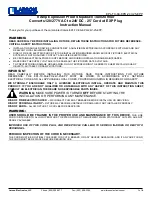
User manual
PONSEL
Reference: NOTICE_ACTEON_2010_v001-UK
V: 001
52/56
-
The protective casing maintains the glass electrode in a moist atmosphere (it is totally leak-tight when
the casing air-hole is positioned between 2 ring-type joints).
Figure 10- Diagram of the pH sensor
13.1.3 Activation
-
Remove the protective casing by pulling and turning the entire assembly
2
.
-
Connect the electrode to the measuring system.
-
Immerse the electrode in the water to be analysed.
Comment:
Between measurements, it is vital to rinse in permuted water (failing this, in Volvic or demineralised water).
-
WHEN HOT: Avoid heat shock. If it is necessary to immerse a cold electrode in a medium
with a temperature greater than 50°C, immerse it three times in short bursts at
intervals of a few seconds.
-
WHEN COLD: Ditto for the operating procedure.
With the plasticized electrolyte, there is no risk of the reference electrode de-
priming. The risk of splicing error, which is low at normal temperatures, does
not increase at low temperatures any more than at high temperatures.
2
Normally, the casing should contain several drops of STORAGE SOLUTION or, failing that, a saturated KCl
solution.
Sensor cable
Shaft
Ring-type joints
Bridge
Centering ring for
both tubes
Protective strainer
REFERENCE PART -
COAXIAL COMBINED
Outer tube
Wire/ref. (Ag-AgCl)
Gelled electrolyte
pH SENSOR PART
Inner tube
Wire (Ag-AgCl)
Internal electrolyte,
pH 7-buffered
Glass bulb, porous to H+ ions





































